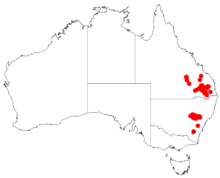Acacia muelleriana
| Acacia muelleriana | |
|---|---|
| Scientific classification | |
| Kingdom: | Plantae |
| Clade: | Tracheophytes |
| Clade: | Angiosperms |
| Clade: | Eudicots |
| Clade: | Rosids |
| Order: | Fabales |
| Family: | Fabaceae |
| Subfamily: | Caesalpinioideae |
| Clade: | Mimosoid clade |
| Genus: | Acacia |
| Species: | A. muelleriana
|
| Binomial name | |
| Acacia muelleriana | |

| |
| Occurrence data from Australasian Virtual Herbarium | |
Acacia muelleriana is a species of Acacia native to eastern Australia.[3]
Description[edit]
The shrub or tree typically grows to a height of 1.5 to 8 m (4 ft 11 in to 26 ft 3 in) and has angled to terete, ridged and glabrous branchlets that have smooth grey bark. The filiform and glabrous leaves have a rachis that is 0.7 to 2 cm (0.28 to 0.79 in) and has one or two, or sometimes three pairs of pinnae that are made up of four to ten pairs of widely spaced pinnules with a linear shape and a length of 8 to 37 mm (0.31 to 1.46 in) and a width of 0.5 to 1.5 mm (0.020 to 0.059 in). The plant blooms between August and December and produces simple inflorescences that occur in terminal panicles with spherical flower-heads with a diameter of 3 to 5 mm (0.12 to 0.20 in) containing 5 to 14 cream-coloured flowers. The thinly leathery and glabrous seed pods that form after flowering are more or less flat and are straight to curved and irregularly constricted between the seeds. The pods have a length of 2.5 to 13 cm (0.98 to 5.12 in) and a width of 5.5 to 7 mm (0.22 to 0.28 in) containing longitudinally arranged seeds.[3]
Etymology & naming[edit]
Joseph Maiden and Richard Baker first described the species in 1893 from a specimen found at the "Foot of ranges forming the southern watershed of the western branches of the Hunter River, New South Wales", and gave it the specific epithet, muelleriana, to honour Ferdinand von Mueller.[2]
Distribution[edit]
It is endemic to central parts of New South Wales from around the Goonoo Forest and the Mudgee district in the south. It is found in a variety of habitat usually around sandstone as a part of dry sclerophyll forest communities.[3]
See also[edit]
References[edit]
- ^ "Acacia muellerina". Australian Plant Name Index, IBIS database. Centre for Plant Biodiversity Research, Australian Government.
- ^ a b Maiden, J.H.; Baker, R.T. (1893). "Description of a new species of Acacia". Proceedings of the Linnean Society of New South Wales. Series 2. 8 (4). p. 515, t. xxv.
- ^ a b c P.G. Kodela (2002). "Acacia muelleriana Maiden & R.T.Baker". PlantNET. Royal Botanic Gardens, Sydney. Retrieved 5 September 2016.
